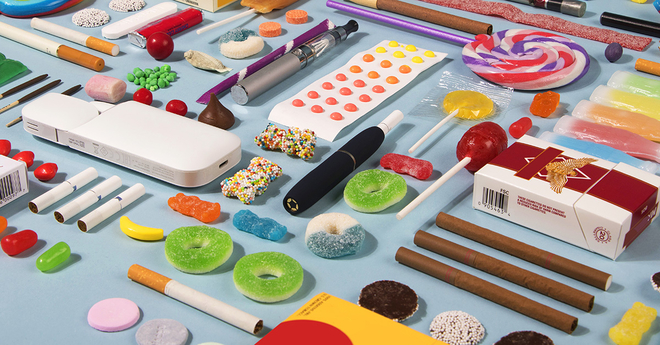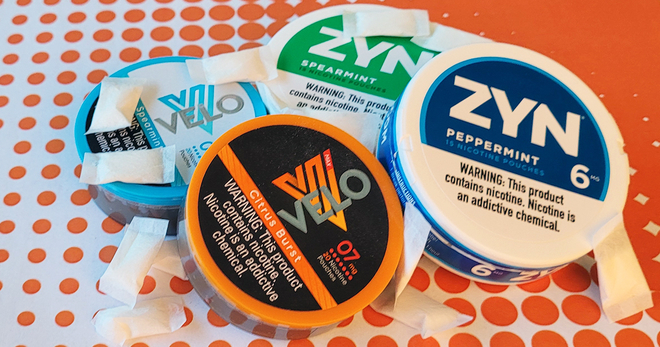E-cigarette and cigarette sales decline after California law eliminates sale of flavored tobacco
California’s policy prohibiting the sale of flavored tobacco products caused a significant drop in e-cigarette and cigarette sales in the state, according to new research published in the American Journal of Public Health by the CDC Foundation, Truth Initiative, and University of Southern California.
In the first year and a half after the policy was implemented in January 2023, e-cigarette sales declined by 37% – measured as average quarterly nicotine milligrams sold per person – and cigarette sales, or cigarette packs sold per person, decreased by 10.6% in California retail outlets.* Meanwhile, sales in neighboring states were not impacted, underscoring that the state policy did not cause a significant increase in sales in nearby states – a claim the tobacco industry has made in its efforts to oppose state flavored tobacco policies.

Evading the law: Disposable e-cigarettes and “non-menthol“ products
Although California’s law led to overall declines in cigarette and e-cigarette sales, some concerning trends continued. Illegal flavored tobacco products kept selling despite the policy—especially disposable e-cigarettes, which made up 94% of e-cigarette sales that did not comply with California’s law. According to a previous report by CDC Foundation and Truth Initiative, the state’s enforcement strategy was updated over time to increase the policy’s effectiveness.
The study also found a sharp rise in products labeled “non-menthol” or “clear,” which contain cooling agents that mimic menthol’s effects. After Massachusetts and California successfully ended the sale of flavored tobacco and nicotine products, including the sale of menthol flavored cigarettes, tobacco companies pivoted to marketing new “non-menthol” cigarettes in these states, including new cigarettes like Camel Crisp, Newport Non-Menthol, and Kool Blue. Research shows that these products contain synthetic cooling chemicals in place of menthol to achieve similar cooling sensory effects.
In response to the risks posed by these products, California expanded its law in January 2025 to ban products that produce a “cooling sensation.” Still, the increase in such products was smaller than the overall drop in tobacco sales.
Ongoing monitoring of tobacco product sales
The study, which analyzed retail scanner data, is the first known formal evaluation of the impact of California’s comprehensive flavored tobacco law on sales. It adds to a growing body of research by CDC Foundation, Truth Initiative, and other partners that monitor tobacco sales.
A recent study by CDC Foundation and Truth Initiative found that the e-cigarette market is increasingly dominated by disposable products that have gotten bigger and cheaper, delivering more nicotine at price points more accessible to young people. Researchers analyzed monthly e-cigarette sales during the three and a half years between February 2020 and June 2024 and found that the total amount of nicotine sold jumped by 249.2%, even though the number of e-cigarette units sold each month rose by only 34.7%. This increase represents more than seven times the growth in unit sales.
Since 2019, the CDC Foundation and its partners—the Centers for Disease Control and Prevention (CDC) and Truth Initiative—have conducted research on the impact of statewide flavored tobacco restrictions on sales of tobacco products, e-cigarette use by young people, and the effectiveness of flavored e-cigarette restriction policies, with the goal of keeping children and teens from accessing these addictive products.
In addition, CDC Foundation’s recently launched, interactive website, TobaccoMonitoring.org, offers easy access to the latest tobacco product sales data for the United States and select states. With data from 2019 through 2024, the site provides comprehensive and up-to-date information on e-cigarette and nicotine pouch sales trends.
*Retail sales data from Circana are market-level representative for covered brick-and mortar retailers (e.g., food and grocery stores, drug stores/pharmacies, convenience stores, mass merchandisers, club stores, dollar stores and military stores/exchanges). Data do not include purchase age and are not representative of online sales or sales from tobacco or vape specialty stores. Data were analyzed by the CDC Foundation and Truth Initiative.
More in emerging tobacco products
Want support quitting? Join EX Program
By clicking JOIN, you agree to the Terms, Text Message Terms and Privacy Policy.
Msg&Data rates may apply; msgs are automated.



